Abstract
Seedling establishment ofPolygonum cuspidatum (Seib. et Zucc.) andPolygonum weyrichii (F. Schmit) var.alpinum (Maxim.), dominant early-successional species in a volcanic gravel area on Mt Fuji, Japan, was compared for current-year seedlings at 2500 m a.s.l. The rate of survival in the first winter after germination at 2500 m was 2% and 24% forP. cuspidatum andP. weyrichii seedlings, respectively, and correlated with the upper distribution limit of each (2500–2600 m forP. cuspidatum; 3200–3300 m forP. weyrichii). The critical size for survival was 12 mg dry weight for overwintering current-year seedlings of both species. At 2500 m, the percentage of seedlings that attained the critical size for survival at the end of the first growing season was 19% and 85% forP. cuspidatum andP. weyrichii, respectively. Growth curves indicated that the larger-seeded characteristic ofP. weyrichii contributed to larger end-of-season size and resulted in higher rate of seedling survival at 2500 m, compared with smaller-seededP. cuspidatum. Current-year seedlings ofP. weyrichii, at least up to 3250 m, attained the first year annual growth critical for overwintering and therefore for successful seedling establishment, due to the large-seeded characteristic. At the top (3770 m) beyond the upper distribution limit ofP. weyrichii, most seedlings raised artificially failed to attain the critical size for survival in the first growing period due to the reduced growing period. Failure of seedling establishment would thus appear to restrict the distribution of the species at altitudes higher than 3300 m.
Similar content being viewed by others
References
Baker G. (1972) Seed weight in relation to environmental conditions in California.Ecology 53: 997–1010.
Billings W. D. (1974) Adaptations and origins of alpine plants.Arctic and Alpine Research 6: 129–142.
Black J. N. (1958) Competition between plants of different initial seed sizes in swards of subterranean clover (Trifolium subterraneum L.) with particular reference to leaf area and light microclimate.Australian Journal of Agricultural Research 9: 299–318.
Black J. N. &Wilkinson G. N. (1963) The role of time of emergence in determining the growth of individual plants in swards of subterranean clover (Trifolium subterraneum L.).Australian Journal of Agricultural Research 14: 628–638.
Bliss L. C. (1985) Alpine. In:Physiological Ecology of North American Plant Communities (eds B. F. Chabot & H. A. Mooney) pp. 41–65. Chapman and Hall, London.
Friend A. D. &Woodward F. I. (1990) Evolutionary and ecophysiological responses of mountain plants to the growing season environment.Advances in Ecological Research 20: 59–124.
Grime J. P. (1979)Plant Strategies and Vegetation Processes. John Wiley, Chichester.
Gross K. L. (1984) Effects of seed size and growth form on seedling establishment of six monocarpic perennial plants.Journal of Ecology 72: 369–387.
Gross K. L. &Soule J. D. (1981) Differences in biomass allocation to reproductive and vegetative structures of male and female plants of a dioecious, perennial herb,Silene alba (Miller) Krause.American Journal of Botany 68: 801–807.
Harper J. L. (1977)Population Biology of Plants. Academic Press, London.
Harper J. L. &Clatworthy J. N. (1963) The comparative biology of closely related species. VI. Analysis of the growth ofTrifolium repens andT. fragiferum in pure and mixed populations.Journal of Experimental Botany 14: 172–190.
Harper J. L., Lovell P. H. &Moore K. G. (1970) The shapes and sizes of seeds.Annual Reviews of Ecology and Systematics 1: 327–356.
Houssard C. &Escarré J. (1991) The effects of seed weight on growth and competitive ability ofRumex acetosella from two successional old-fields.Oecologia 86: 236–242.
Janzen D. H. (1969) Seed-eaters versus seed size, number, toxicity and dispersal.Evolution 23: 1–27.
Maruta E. (1983) Growth and survival of current-year seedlings ofPolygonum cuspidatum at the upper distribution limit on Mt Fuji.Oecologia 60: 316–320.
McWilliams E. L., Landers R. Q. &Mahlstede J. P. (1968) Variation in seed weight and germination in populations ofAmaranthus retroflexus L.Ecology 49: 290–296.
Salisbury E. J. (1942)The Reproductive Capacity of Plants. G. Bell & Sons Ltd, London.
Stanton M. L. (1984) Seed variation in wild radish: Effect of seed size on components of seedling and adult fitness.Ecology 65: 1105–1112.
Tada T. (1987) Size-dependent perennation bud formation and its effect on seedling establishment inVeronicastrum sibiricum ssp.japonicum.Botanical Magazine, Tokyo100: 9–16.
Wardle P. (1973) New Zealand timberlines.Arctic and Alpine Research 5: A127–135.
Weis I. M. (1982) The effects of propagule size on germination and seedling growth inMirabilis hirsuta.Canadian Journal of Botany 60: 959–971.
Woodward F. I. &Jones N. (1984) Growth studies of selected plant species with well-defined European distributions.Journal of Ecology 72: 1019–1030.
Wulff R. D. (1986) Seed size variation inDesmodium paniculatum. II. Effects on seedling growth and physiological performance.Journal of Ecology 74: 99–114.
Young S. B. (1971) The vascular flora of Saint Lawrence Island, with special reference to floristic zonation in Arctic Regions, section II.Contributions to Gray Herbarium 202: 77–115.
Yura H. (1988) Comparative ecophysiology ofLarix kaempferi (Lamb.) Carr. andAbies veitchii Lindl.Ecological Research 3: 67–73.
Author information
Authors and Affiliations
About this article
Cite this article
Maruta, E. Seedling establishment ofPolygonum cuspidatum andPolygonum weyrichii var.alpinum at high altitudes of Mt Fuji. Ecol. Res. 9, 205–213 (1994). https://doi.org/10.1007/BF02347496
Received:
Accepted:
Issue Date:
DOI: https://doi.org/10.1007/BF02347496




